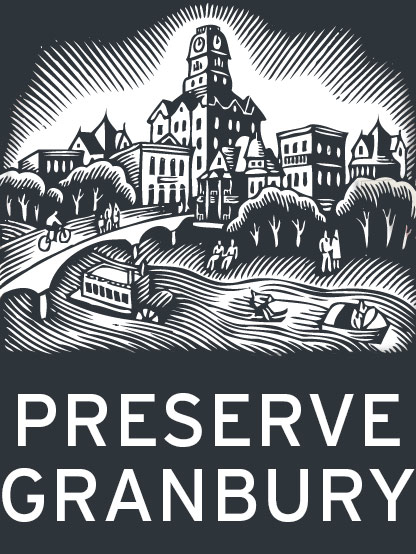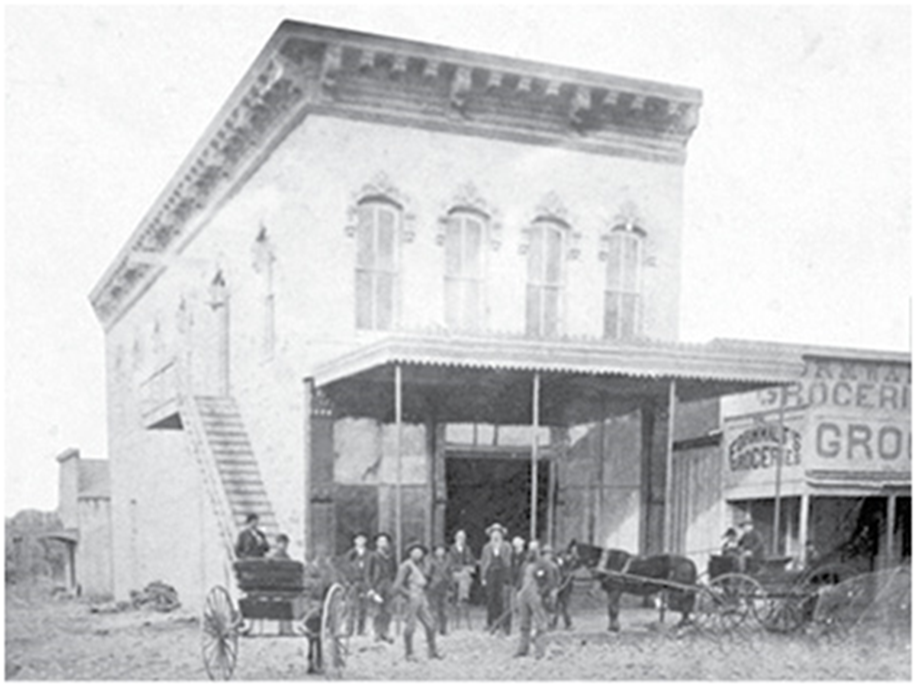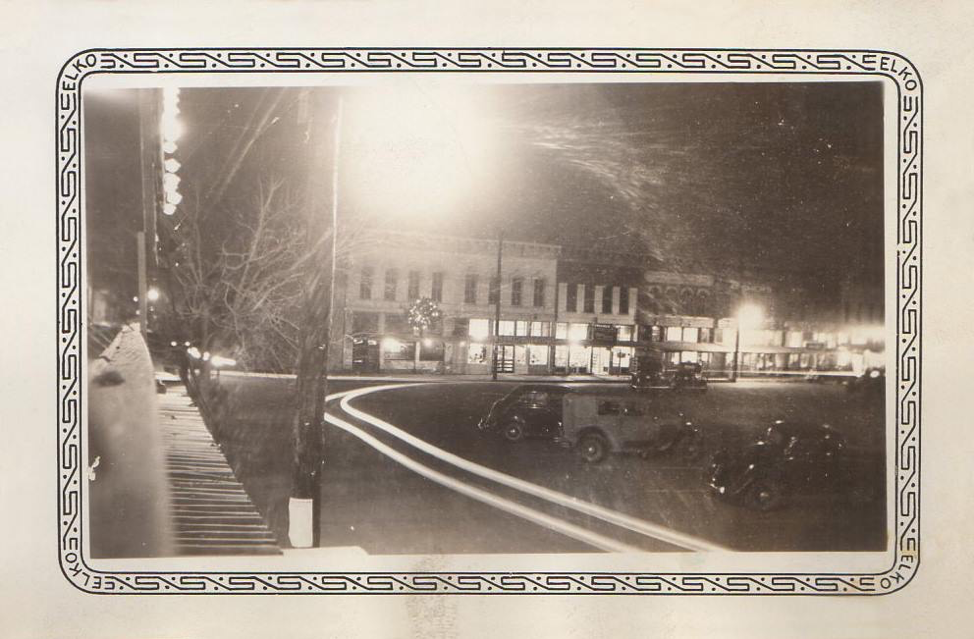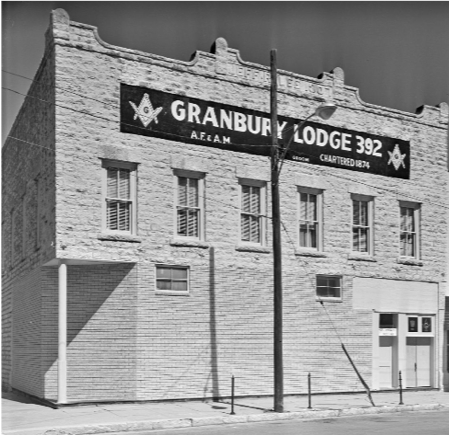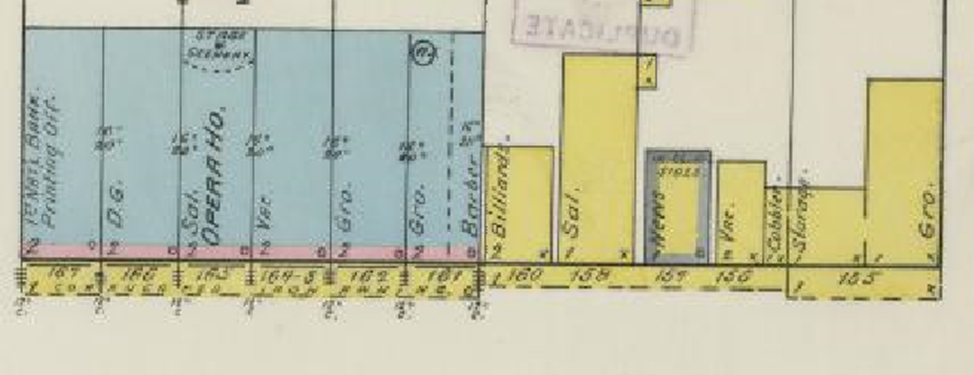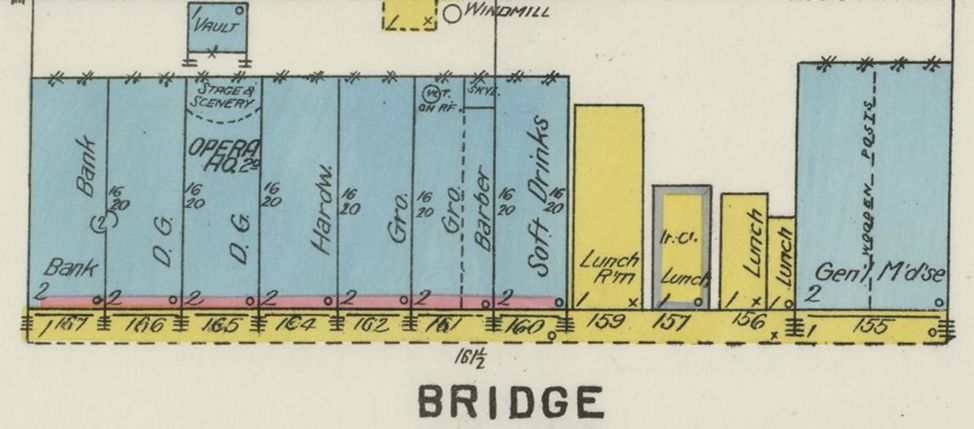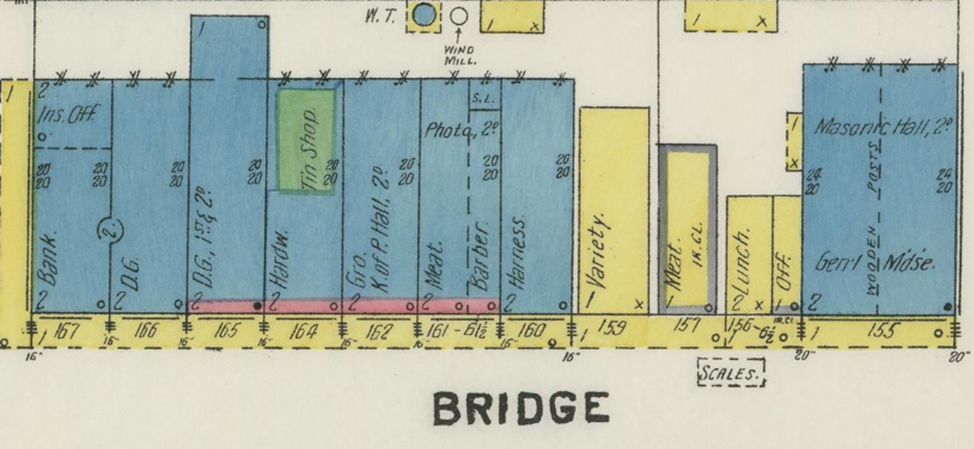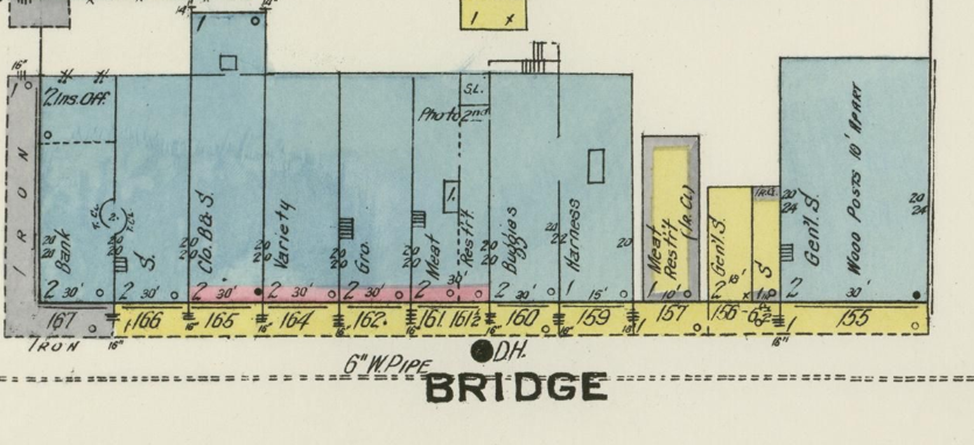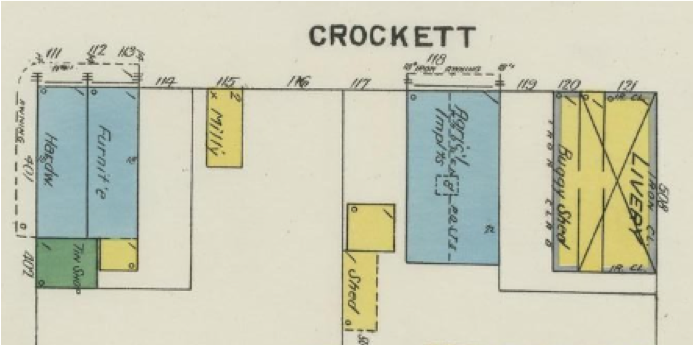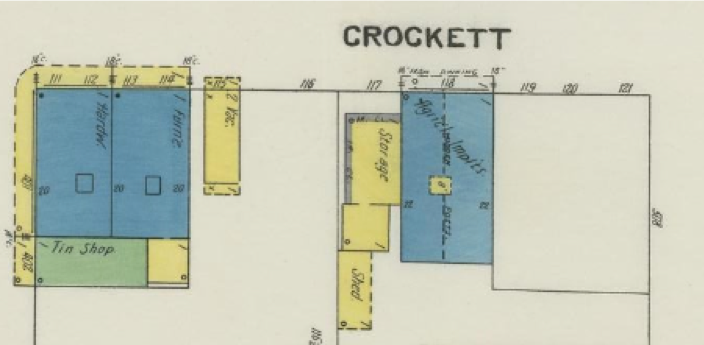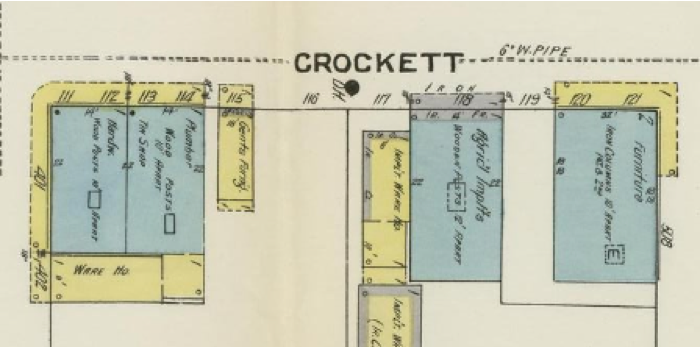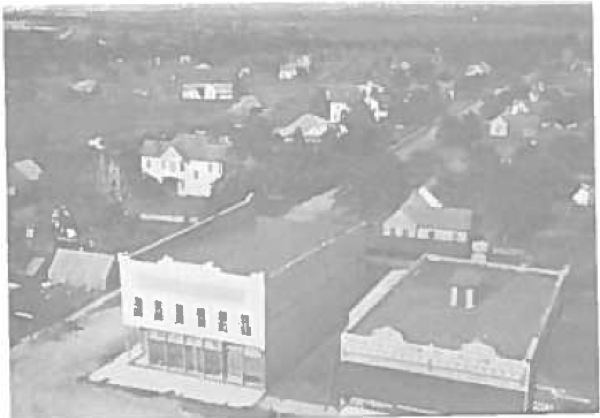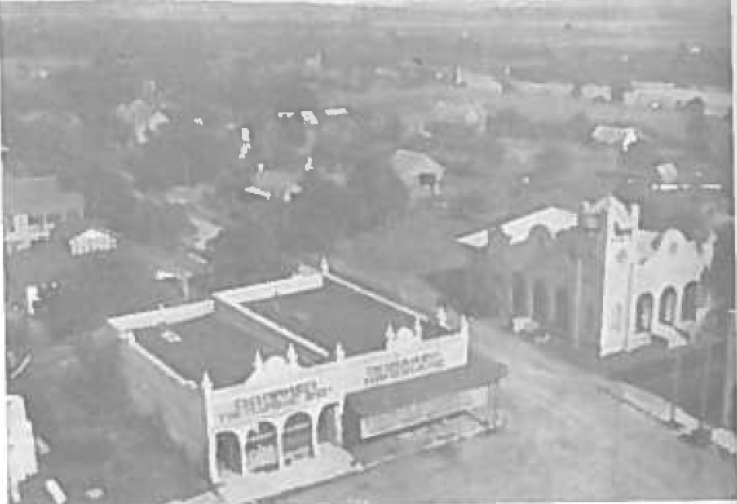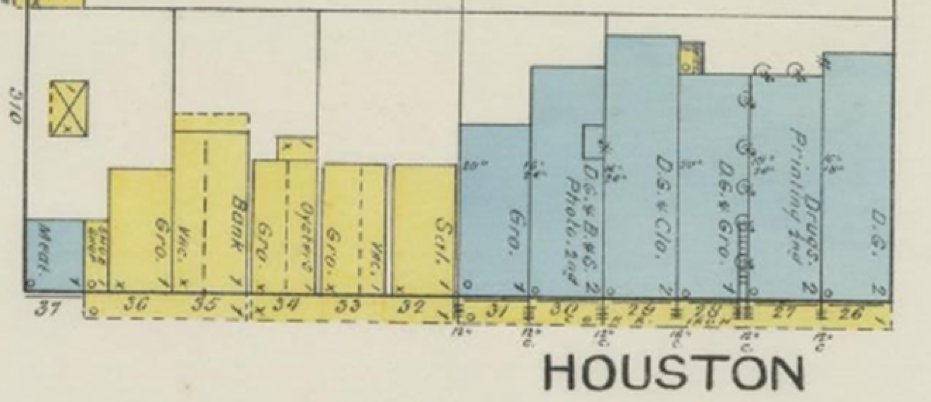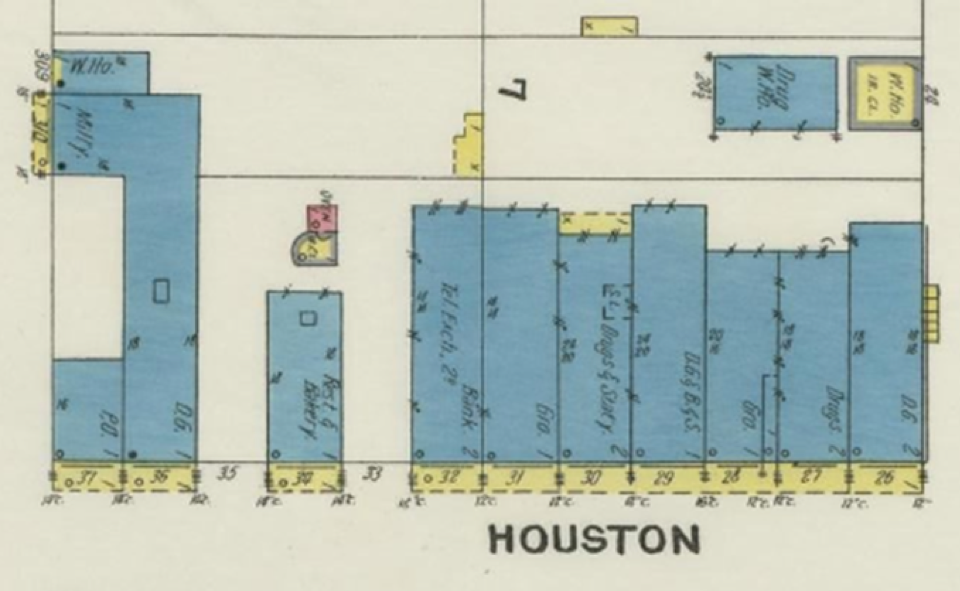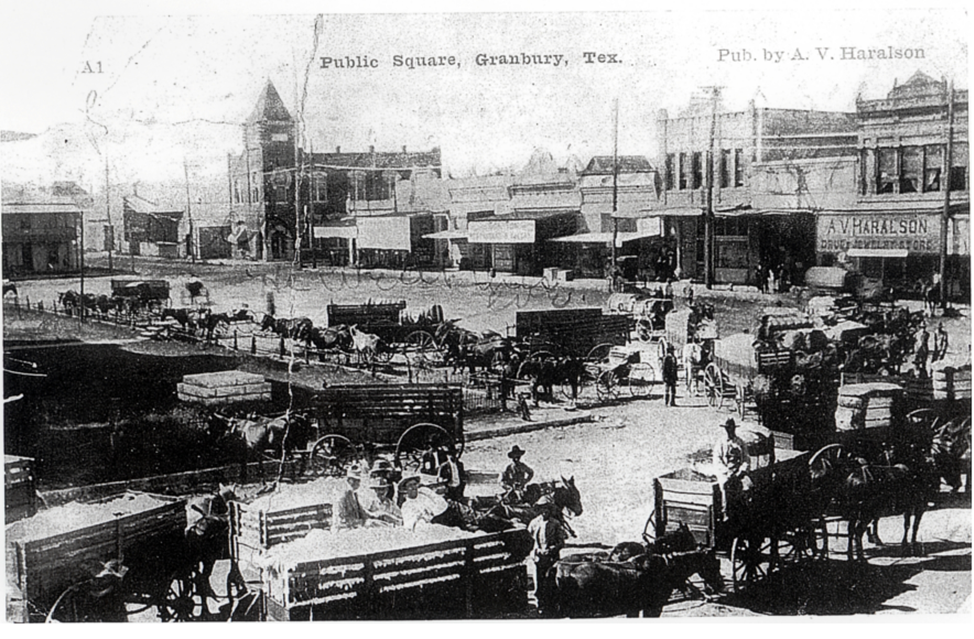GRANBURY SCHOOLS
1800s – early 1900s
Pioneers from the Upland South surged into the North Central region of Texas after it became a state in 1845, with the first Anglo settlers venturing west of the Brazos River in the 1850s. Like settlers throughout Texas, they built a schoolhouse in each small community and families hired and paid the teacher. In 1900, W. H Barker, an early resident of Hood County, shared his memories of education in the county’s first settlements, and recalled that families paid their community’s teacher from $1 to $1.50 per student. He remembered attending school in a log cabin with dirt floors and long hand-hewn wooden benches.1 Recognizing a need to support public education in the new state, leaders established a permanent school fund for public schools in 1854.
The Texas legislature created Hood County in 1866, and by 1871, residents established Granbury, the county seat, along a bend in the Brazos River. There is record of a public school in Granbury in 1871, taught by A. P Harbin. The school’s enrollment was so high that year that Harbin had to hire an assistant to teach the girls. In 1874, Hood County had a board of school directors with four members presided over by Granbury merchant A.P. Gordon, who also served as school examiner and county superintendent.
County Judge T.J. Duke created a Granbury Community School in 1883 in response to a petition from three community leaders, W.A. Duke, A.P. Gordon, and H.E. Hanna. Judge Duke appointed the petitioners as trustees and designated $650.09 from the county treasury for “maintenance of their public school.” The location of this school in Granbury is unknown.
In 1873, the Methodist District opened Granbury College and High School in a rock building on the southeast corner of the Hood County Courthouse square, and by 1875, citizens of Granbury raised the money to construct a three-story limestone building on a prominent hill north of the courthouse square. This building burned down in 1887, but was soon replaced by another three-story limestone building on the same spot.
A series of wet years during the early 1880s benefiting the local agricultural economy, along with the arrival of the Fort Worth and Rio Grande Railroad in 1887, caused an economic boom in Granbury and Hood County. In the early twentieth century, the county achieved a population high of 10,008 and Granbury had 2,250 residents.
In August 1891, the City of Granbury purchased Block 42, six blocks west of the Hood County Courthouse Square, from Catherine Crites for $1,200. The city constructed a frame, two-story schoolhouse with a central tower and wrap-around front porch on the eastern edge of the lot, facing east along Hannaford Street. This lot remained the traditional home to Granbury school buildings for more than 100 years.
In 1893, County Judge George Riddle apportioned state funding at a rate of $5 per student to 38 community schools within Hood County, including the City of Granbury public school and its “colored school.” Before the 1900 to 1901 school term, the Granbury School Board hired five female teachers and two male administrators. Superintendent J.D. Sandeler received a raise to $100 per month to entice him to remain for the eight-month school year.
early 1900s
City of Granbury voters approved $25,000 of bonds in 1917 to construct a masonry school building “on the block of land upon which the present old school building has been situated for several years.” The next year, the city constructed a three-story Beaux Arts-style school building of red brick. The new building featured nine classrooms and a small auditorium, and was located on the northern edge of lot 42, facing north along West Bridge Street. It replaced the existing frame school building, which was demolished.
The same year, the students of Granbury High School published their first yearbook, called “The Peak.” Students’ pride in their new school is reflected in the full-page black-and-white photo of the building on page 6 and in the framed small photo along the lower border of each page of the yearbook. They dedicated their first yearbook to “the defenders of the red, white and blue.” The yearbook features photos of four high school teachers who instructed 17 seniors, 14 juniors, 18 sophomores and 16 freshmen.
During the late nineteenth century, a series of state laws granted cities and towns more freedom to develop and administer schools, leading to the creation of local independent school districts; by 1900, Texas boasted 526. State voters passed the Better Schools Amendment. In 1920, allowing increases in local taxation for education. These changes led residents to approve creation of Granbury Independent School District in 1923. The new district assumed the city’s school bond indebtedness and taxed residents at a rate of 75 cents per $100 evaluation of property. In 1924, the Parent Teachers Association raised money to construct cement sidewalks around the school building and seven seniors graduated, reflecting a decline in local population. During the 1928 semester, the district had a total enrollment of 263, with 102 students attending Granbury High School.
In Hood County, as throughout Texas and the Southern United States, segregation was the norm, and African American children in Granbury attended a separate public school located north of the railroad tracks within their small community. In 1946, Granbury built a new school for African American students and hired one teacher, Eva May Williams, to teach there. Faced with losing thousands of dollars in federal funding, the district integrated its schools in 1964, admitting thirteen African American students to the district’s main campus.
The district school board recognized a need for additional facilities in 1935, submitting a $12,000 bond to the voters of the district in a special election. Articles in the Granbury News encouraged district voters to approve the bond, which would provide five classrooms and a small auditorium for elementary grades, and “will not affect your taxes.” Voters approved the bond 79 to 27.10 Fort Worth architect C.M. Love designed the Art Deco brick school, which is still standing, and Abilene Construction Company completed the building in September. Located on the west side of Lot 42 along Morgan Street facing east, this school marked an expansion of the district to two multi-classroom schools.
By the 1946 to 1947 school year, 510 students attended Granbury public schools, served by five buildings, all standing on Block 42: the five-room elementary for grades 1 to 5; the nine room, three-story building for all other grades with small auditorium; a small shop building used for vocational and agricultural classes; and a small lunch room.
In November 1947, voters approved annexing nine smaller school districts into Granbury Independent School District. The school districts were Thorp Spring, Waples, Fairview, Neri, Temple Hall, Rough Creek, Friendship, Rocky Point, and Shady Grove. Between 1958 and 1969, Mambrino, Acton, and Cresson schools consolidated into Granbury Independent School District, creating a district that encompassed 244 square miles.
Granbury School District hired Fort Worth architect Wyatt Hedrick, who designed Will Rogers Auditorium among hundreds of other Texas buildings, to design and oversee construction of the community’s first gymnasium and auditorium for approximately $49,000. After Superintendent W.F. Decker passed away suddenly during construction, the school board voted to name the building Decker Gym in his honor. Thomas H. Cadenhead and Sons of Fort Worth constructed the gymnasium and auditorium on ball fields on Block 41, located across West Bridge Street north of the three-story brick building, which had become Granbury High School.
after 1950s
During the 1950s, Granbury School District built a new mid-century modern one-story high school, designed by Stanley Brown of Dallas, just west of Decker Gym on the south side of Block 41, along West Bridge Street facing south. At the end of the decade, the district added a junior high school wing on the west end of the high school. The 1960s began with the district building a new elementary school and cafeteria behind the high school and junior high school, on the west side of Block 41, facing west. After it opened, the district in 1965 demolished the 1917 three-story brick school building on Block 42.
In 1958, the average daily attendance in Granbury’s schools was 702; by 1969 it was 899. Base pay for a beginning teacher with a bachelor’s degree was $3,204, and by 1969 it was$5337. As the community braced for growth and new development following the creation of Lake Granbury in 1969, a reporter for the Hood County News Tablet wrote:
We cannot bury our heads in the Brazos River Sands. Within a few short months sailboats and water skiers will replace the giant pecan and oak trees . . . The Granbury School District will need new classrooms, new student desks and equipment, and more teachers. The lack of a good education system can spoil the student as easily as sparing the rod.
Indeed, the 1970s brought revitalization and progress to Granbury with the creation of the lake and restoration of the courthouse and its square. Anticipated growth materialized, April 3, 2019 and, in 1971, voters approved a $2.2 million bond to construct a new high school. Located 1.4 miles west of the courthouse square, the modern building featured 80,000 square feet and accommodations for 750 students, with flexibility to expand to serve 1,500 students. The watershed developments that necessitated a new high school ushered in a period of rapid change and development for Granbury and its school system. At the beginning of the 2018 school year, Granbury Independent School District had reached a size of 254 square miles with 7,135 students enrolled for classes on eleven campuses.
Endnotes
1 “County Schools Had Humble Beginning,” Hood County News-Tablet, August 11, 1966, p. 16. 2 “Granbury Schools Have Colorful Past,” Hood County News, February 28, 1974, p 8.
3 Sanborn Insurance Company Map of Granbury, Hood County Texas, 1910, Library of Texas online.
4 “Granbury Schools Have Colorful Past,” Hood County News, February 28, 1974, p 8.
5 “School Fund Apportionment,” Granbury News, September 28, 1893, p. 1.
6 City of Granbury, City Council Minutes, February 20, 1918, available at the Granbury Depot Archives.
7 “Statement from School Board,” Granbury News, May 25, 1923, p. 5.
8 “Granbury Public School Report,” Granbury News, November 2, 1928, p. 1.
9 “184 Texas School Districts Facing Loss of Federal Aid,” Dallas Morning News, April 10, 1962, Section 1, p. 4 and “40 School Districts Join Integrated List,” Dallas Morning News, March 25, 1964, Section 1, p. 4.
10 “Proposed School Bonds Will Not Affect Your Taxes,” Granbury News, April 5, 1935, p. 1. 11 W.F. Decker and Joe Enoch, Letter to Surplus Property Utilization Program, June 15, 1947, Granbury School Board Minutes, Available at Granbury Independent School District’s Superintendent’s Office.
12 “Comparison of Ten Year Period Shows Changes in Granbury School District,” Hood County News Tablet, July 24, 1969, p. 1.
13 Granbury ISD Boasts Largest First Day Enrollment,” Granburyisd.org, www.granburyisd.org.
April 3, 2019
HISTORIC DOWNTOWN SQUARE
D’Vine Wine | 107 East Bridge Street

Hardware and Tin Shop | http://dvinewinegranbury.com
Visit Granbury’s own full production winery on the historic Granbury Square. Our winery and gift shop is located right in the heart of historical Granbury, Texas. Whether you are new to wine or a connoisseur, our mission is to create an inviting environment where visitors and members of our community have a place to enjoy learning about wine and the wine process. As a neighborhood friendly establishment, we’re aim to bring friends and community together through our love of wine.
Texas Historic Landmark Marker: Marker Number 2375; A cabin-dotted Woodland in 1870, this square soon had buildings of stone quarried less than a mile away. Investor John D. Baker built this structure in 1882 and in 1890 sold it to saloonkeepers Aston and Landers. Extensive repairs were made in 1891, after a fire in this and neighbor buildings. By 1895, ex-county clerk J.R. Morris had a hardware and tin shop here. Lon Morris, a widely-known lawyer and college benefactor, had his offices on the second floor.
The photo on the below shows the building is used as the Haralan & LeMaster Dry Goods store, the photo taken between 1898 and 1910.
Later, in the mid 1900’s, the housed a boxing club. It was owned for many years by members of the Nutt family. The photo shows the building in 1974, where is served as gas and oil offices, insurance, travel and interior designer’s offices. Kay Davis purchased the building in 1989 or 1990. Ms. Davis ran the Chatterbox dress shop below and used the upstairs as her private residence. She remodeled and removed an elevator, replacing it with the existing stairs. While remodeling in the 1990’s, Kay Davis reports that the contractor discovered this set of stairs which leads back down to the current winery. In 2003, D’Vine Wine previous owners, Karen and Butch Barton (from Pecan Plantation) and Charlene and Ross Meriwether, rented the space for D’Vine Wine from Kay Davis and renovated the dress shop to create an on-site winery. They removed 7 layers of flooring to reveal the beautiful hardwood floors. In 2006, Dr. Tony Hedges and wife Diane Hedges, along with partner Josh Winters, purchased the winery business. Shortly thereafter, Tony and Diane Hedges purchased the building from Kay Davis and after much thought, decided to keep the upstairs intact as one unit. In 2008, Ron Vanmeter also joined them as a partner in the winery business.
First National Bank | 101 East Bridge Street
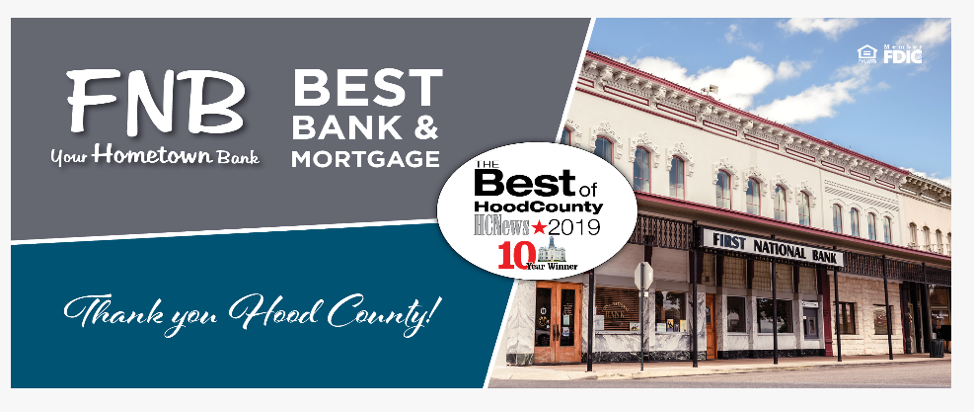
Texas Historic Landmark Marker: Marker Number 6250; Marker Text: First unit in structure was built 1883–year private bank was opened by D.C. Cogdell and John H. Traylor. National Bank charter was issued in 1887 and second structural unit was later acquired. Besides the organizers, officials have included Jeff Nutt (1900-32); C.H. Bencini (1935-36); Jake Green (1936-48); Henry Zweifel (1929-70); John S. Luton (1952- ). The hand-hewn native limestone structure is a good example of Victorian commercial building. Recorded Texas Historic Landmark – 1972
History of the Business:
First National Bank was built in 1883 as a private bank by D.C. Cogdell and John H. Traylor It was chartered in 1887 by Dan Cogdell, John Traylor, E.A. Hannaford, Jess Baker and James H. Doyle.
While the early years of the Bank’s existence were economically prosperous for the area, the Great Depression and droughts of the 1930’s would soon have a negative impact on the community. However, First National Bank persevered through this time and gave the community a sense of hope. We even assumed the accounts of the City National Bank as it fell victim to the times, saving many Granbury residents their hard earned money.
First National Bank continued to grow through the years and serve the community wherever needed, becoming a pillar of strength to the area. During World War II the Bank’s President, Jake Green, served as the chairman of the War Bond Drive, helping accumulate funds for the effort. During the 1960’s the Bank’s Presidents, Henry Zweifel and John S. Luton, as well as Director Norma Crawford, worked hard to bring the damming of the Brazos River to form Lake Granbury, which has had an enormous impact on Hood County. Mrs. Crawford also led the drive to bring renovation to Granbury’s historical square, which is a strong tourist attraction still today.
By the late 1980’s, the Bank began to branch out and provide the community with more convenient locations. Today there are six First National Bank locations in Hood County, helping provide a major source of employment and economic activity for the area. In 2017 the bank is set to open its first full service branch outside of Hood County with our Nolan River Banking Center in Cleburne, TX.
As in the beginning, First National Bank is still a locally owned community bank with its focus on serving the community. While adapting and staying up to date with modern day technologies has helped First National Bank persevere through the years, our real secret to success has been our strong integrity and honesty in our banking relationships, and our continued service to Hood, Johnson, and surrounding areas. If you want friendly, personal, comfortable banking, stop by and visit any one of First National’s offices, where bankers treat customers like family, helping in any way we can, as we have done since 1887.
By 1893, the Sanborn map of Granbury shows the building next door has become a stone structure.
The Victorian commercial structure on the northwest corner of the square was the original bank building. The photo below shows he bank in the early 1930s. Notice the wooden sidewalks on Houston Street. In 1952, the First National Bank expanded into the second building, and in its third building in 1970s, originally using this building as a drive-through bank (see photo below). The First National Bank of Granbury has remained in business in this location since 1887. Notice the elaborate pressed-tin bracketed cornice above most of the buildings on the north side of the square. This cornice was probably expanded from the bank’s original building in 1891, after a fire damaged the four buildings to the east of the corner building. Also notice the old iron late at the base of the original bank building that still bears the inscription, “Traylor and Cogdell, 1883.”
Historic Nutt House Hotel | 117 East Bridge Street
https://www.nutthousehotelgranbury.com/
Texas Historic Landmark Marker Text: Erected for Jesse and Jacob Nutt, blind brothers who aided in establishing county seat at Granbury. Their first (1866) store had been a 16 by 12 log house with a wagon yard in the rear. This structure of hand-hewn Hood county stone was built in 1893 by local contractor Jim Warren. About 1919 Nutt Hotel–famed for dining room–moved in after “grocery” was remodeled. Building has been occupied by 3 generations of the Nutt Family.
Located directly on the Historic Downtown Square in Granbury, Texas! This one of a kind structure was built of hand-hewn Texas limestone in 1893 by brothers Jacob, Jesse and David Lee Nutt, the Historic Nutt House Hotel occupies the site of their original log mercantile store. It was on this very spot that these forward thinking and industrious brothers Jacob and Jesse both of whom were blind from late childhood, began operating their general store in 1874, originally beginning trade from a tent. David Lee, was the much younger brother of Jacob and Jesse and served as their “eyes” in the mercantile store from the time he was twelve.
In 1879 David and his wife Sudie, built a home only a couple of blocks down the street from the store, where they provided lodging for the hotel suppliers, as they had no other place to stay while visiting Granbury on their business trips. After enjoying many years of hospitality within the Nutts’ own residence, the family decided to convert the open second floor of the then enlarged mercantile building into a hotel. The Nutt House Hotel officially opened in 1910, with ten guest rooms, and two luxurious separate baths for both women and men. This incredible building has served as the “Premier Lodging,” on the Granbury square ever since! This inviting and rustic hotel now features seven uniquely different luxury suites, each with expansive spa-like baths. It also has a Grand Sitting Room for it’s guests to enjoy, and countless original features still remain intact, such as the original Grand Staircase, and the authenticated room key holder from 1910! The gorgeous original doors to the ten rooms are a feast for the eyes as well. This preserved and beloved gem, is the Grand Old Lady of the Granbury square, and joyously continues to warmly welcome folks both far and wide to Granbury, with all of it’s charm and warmth. The Nutt House Hotel encapsulates all the authenticity and ambiance of the past, as well as the customary comforts of the present! Breakfast is provided daily, with the purchase of your room reservation.
Jeff Riley Building | 122 North Crockett Street
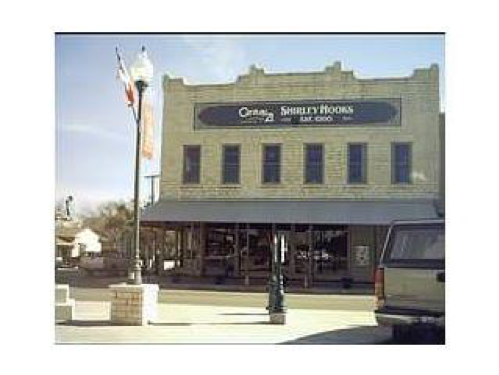
This native limestone structure was built in 1907 on the site of an old livery stable by prominent Granbury citizen, Jeff Rylee. Rylee’s parents were early Hood County settlers, arriving in this area in the late 1850’s. Rylee leased this building to the Gordon-Oxford Furniture Company and Undertakers. The firm’s licensed mortician was a woman, Edith Oxford Gordon. The Granbury Masonic Lodge chartered in 1874, purchased this building in the mid-1930s. The Lodge continues to use the building’s second floor as it’s meeting hall. Notice this building’s heavy stone parapet that contains Jeff Rylee’s name and the construction date. There is a patented iron threshold at the entrance bearing Rylee’s name.
This is the building in 1974.
Thomason Building, Doug’s Sports House | 120 North Crockett
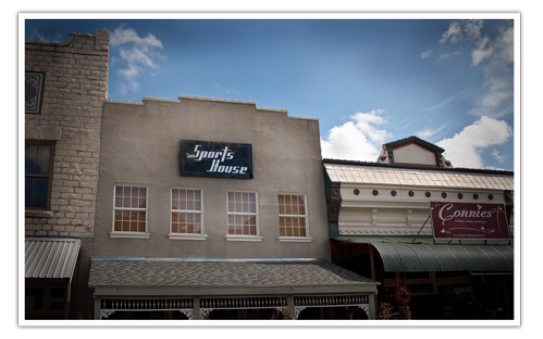
Doug’s Sports House has the best selection around of everything sports. From fishing to football Doug’s has great gifts for any sports enthusiast.
If you are looking for a unique gift or another way to show your school spirit come visit us at Doug’s Sports House.
The small lot where this building now stands was vacant for many years. This building was constructed in the mid 1940s for Herman D. Thomason, who was a partner in the Goforth-Thomason Hardware Store. Thomason was from nearby Tolar and he was a schoolteacher for many years. Thomanson’s daughter said that he had this building constructed because he didn’t like to see empty lots on the Town Square.
The Thomason Building’s first occupant was the Granbury Dress Manufacturing Co., established in 1943. The dress manufacturing company’s sewing machines were located in the lower level of the Masonic Lodge Building next door. After the Thomason Building was completed, the dress manufacturing company used it for storage of dresses and equipment. In 1944, the dress manufacturing company’s payroll was $1,000 per week, and each week its employees churned out 80 dozen “Marcy Lee” dresses. The completed dresses were picked up by large trucks and taken to Dallas, where they were distributed to retailers throughout the country. All of the women who worked at the dress manufacturing company were from Hood County. In October 1944, the Hood County Tablet wrote that “a number of seamstresses were out harvesting the county’s bumper peanut crop, but they planned to return to dress manufacturing in a few weeks.”
Baker-Rylee Building and Town Square Service Station | 100 North Crockett

Photo courtesy University of North Texas Libraries, The Portal to Texas History, texashistory.unt.edu; crediting Texas Historical Commission
This cut limestone structure was built in 1895 to house the hardware operation of D.O. Baker and J.D. Rylee. The following year, Baker’s brother, Jess, joined the partnership and in 1898 the store became the Baker Hardware Co. Baker and Rile had a well dug inside their hardware store, and they installed a windmill and water tank on the roof, therefore they had their own 1890s water works system.
The first automobiles in Granbury appeared in 1907, registered to a handful of wealthy businessmen. Until the 1920s, very few residents of Granbury owned cars, and roads in the area were virtually impassable. Bur “Highway No. 10” between Granbury and Fort Worth was completed after 1924, and five years later Hood County had 30 miles of paved roadway. In 1929, this building was converted to a gasoline service station by the Transcontinental Oil Company of Tulsa, Oklahoma. Part of the building was removed to provide drive-through auto access, and gasoline pumps were added. From 1930 up to World War II, this was the busiest corner in Granbury. Both the service station and a café added during the 1930s were open 24 hours a day. Today there is a bypass for U.S. Highway 377, but at that time, Pearl Street was the main route through the city.
HISTORIC STREETS
Bridge Street
Crockett Street
Houston Street
The 1893 Sanborn map shows the northern half of the street was all rock structures. The rest, except the building on the south corner, were constructed from wood. Maps courtesy University of North Texas Libraries, The Portal to Texas History, texashistory.unt.edu; crediting Texas Historical Commission
